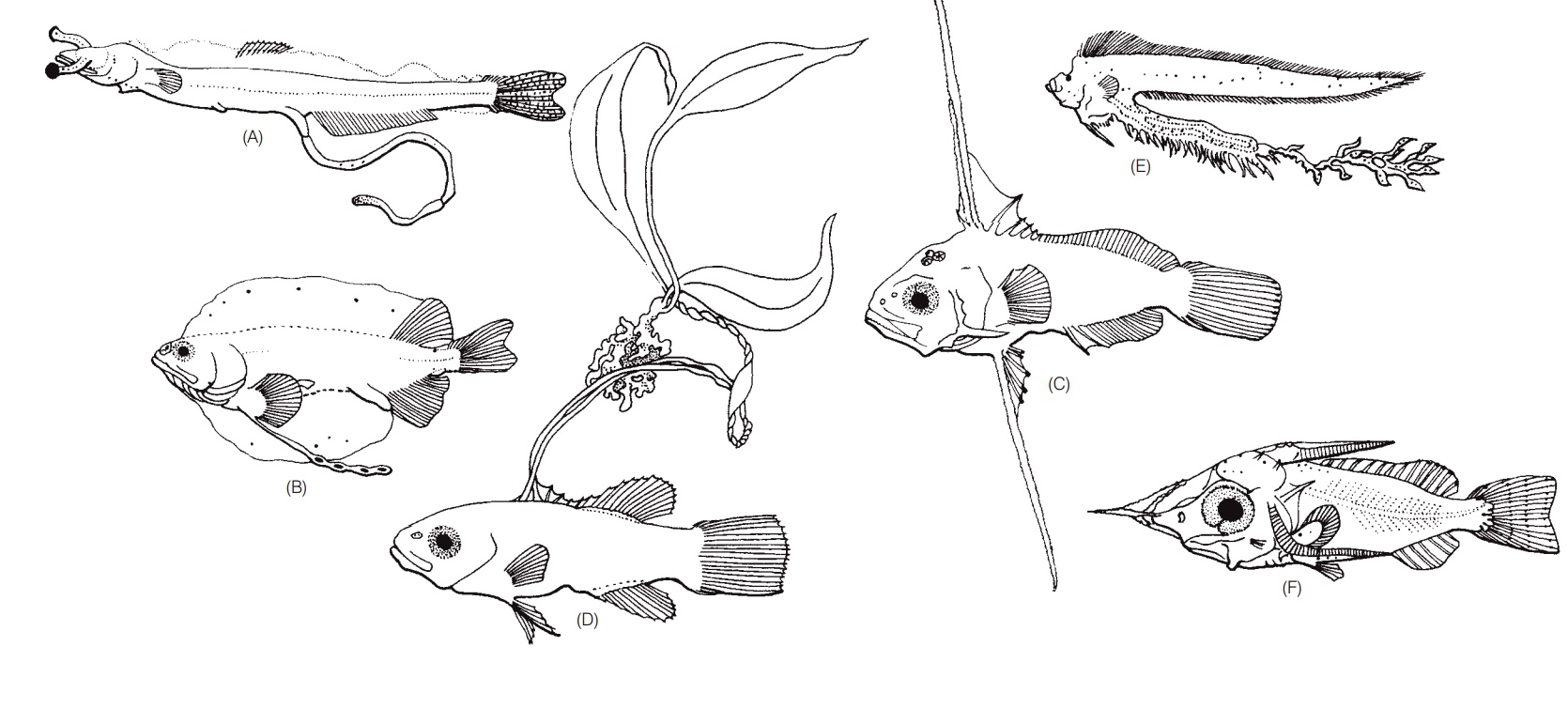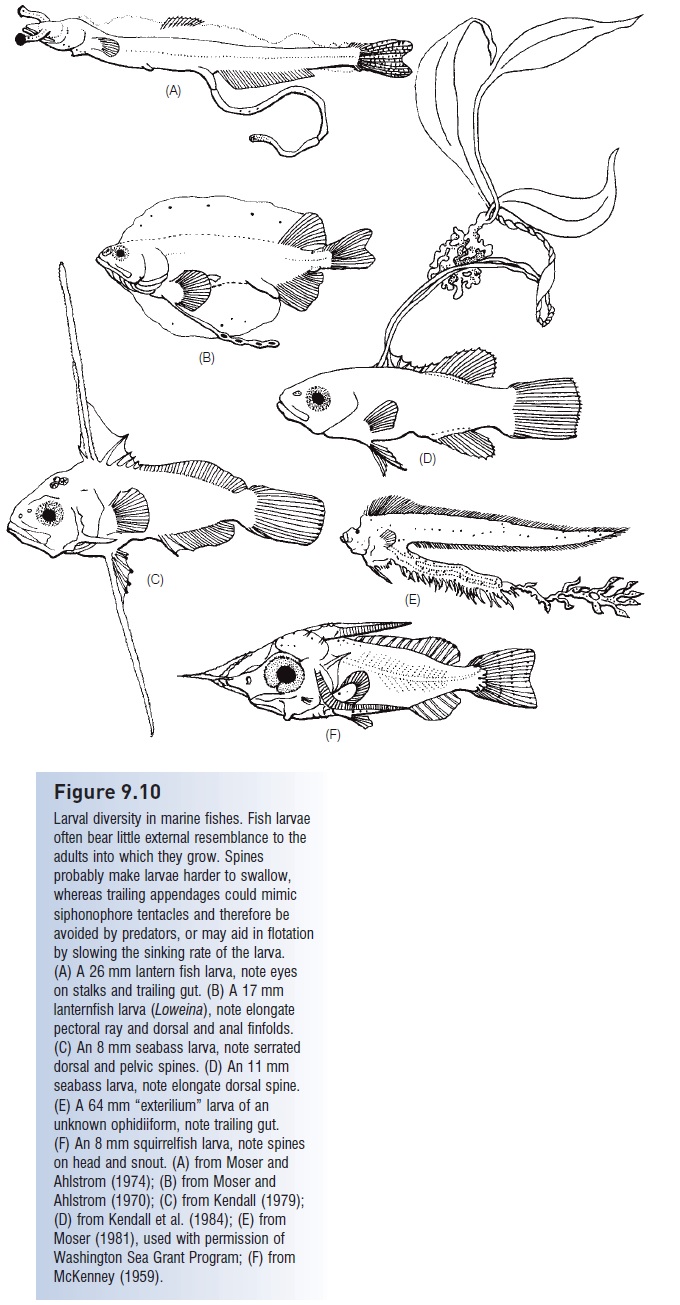Chapter: The Diversity of Fishes: Biology, Evolution, and Ecology: Early life history
Larval morphology and taxonomy

Larval morphology and taxonomy
Whereas eggs tend to be generally similar across many taxa, the larvae that emerge are strikingly distinct and often rather bizarre when compared with our expectations of fish morphology. The challenges to ichthyologists include identifying and linking larvae with their adult counterparts. Equally challenging is understanding the adaptive signifi - cance of the various, seemingly incongruous, structures that

Figure 9.10
Larval diversity in marine fishes. Fish larvae often bear little external resemblance to the adults into which they grow. Spines probably make larvae harder to swallow, whereas trailing appendages could mimic siphonophore tentacles and therefore be avoided by predators, or may aid in flotation by slowing the sinking rate of the larva. (A) A 26 mm lantern fish larva, note eyes on stalks and trailing gut. (B) A 17 mm lanternfish larva (Loweina), note elongate pectoral ray and dorsal and anal finfolds. (C) An 8 mm seabass larva, note serrated dorsal and pelvic spines. (D) An 11 mm seabass larva, note elongate dorsal spine. (E) A 64 mm “exterilium” larva of an unknown ophidiiform, note trailing gut. (F) An 8 mm squirrelfish larva, note spines on head and snout. (A) from Moser and Ahlstrom (1974); (B) from Moser and Ahlstrom (1970); (C) from Kendall (1979); (D) from Kendall et al. (1984); (E) from Moser (1981), used with permission of Washington Sea Grant Program; (F) from McKenney (1959).
One key is that larvae, although capable of locomotion, are at least initially relatively helpless and vulnerable. They are too slow to actively avoid most predators, other than those that also fl oat with currents, such as various cnidarians with stinging cells. Many predators on pelagic larvae are small, gape-limited, and orient visually to their prey. To counteract these predators, larvae rely on structures that make them spiny and increase their body dimensions, or they mimic potentially noxious planktonic animals such as siphonophores (Fig. 9.10). Some structures such as extended fins, skin fl aps, and gelatinous body coatings may also slow the sinking rate of larvae, keeping them in more nutrient-rich surface waters. Pigmentation patterns, which are often characteristic of larval stages and useful for identification, may screen harmful ultraviolet rays. This would apply particularly to the heavy melanistic pigmentation found on many species of neustonic or surface-dwelling marine larvae (Moser 1981).
Marine fish larvae have proven mysterious to ichthyologists, our knowledge having grown slowly and incrementally. Some of this history is reflected in the names given to larval stages, where many years of search were required to link larval and adult animals. Metamorphosis so radically alters many species that the two stages bear little obvious resemblance, attesting to different selective regimes and adaptations of different life history stages. The situation can be further complicated by stages intermediate between larvae and juveniles, sometimes called prejuveniles, which are also distinct. For example, the amphioxides larva of branchiostomatid lancelets and the kasidoron larva of the deepsea gibberfishes (Gibberichthyidae) once had familial status, the Amphioxididae and the Kasidoridae respectively. Generic status was initially given to a number of small fishes that are now identified as larvae or prejuveniles of wellknown taxa, such as
Ammocoetes (lampreys),
Leptocephalus (anguilliform eels),
Tilurus
and Tiluropsis(notacanthoid halosaurs),
Querimana (mullets),
Vexillifer (pearlfishes),
Rhynchichthys (squirrelfishes),
Dikellorhynchus (tilefishes),
Acronurus (surgeonfishes), and
Ptax (snake mackerels).
The scutatus larva of the Big-eyed Frogfish, Antennarius radiosus, was initially described as its own genus and species, Kanazawaichthys scutatus. These and other distinctive larval stages are still given separate descriptive names, such as the exterilium (“external gut”) stage of ophidioid cuskeels (Fig. 9.10E), the “stalk-eyed” stylophthalmus larva of idiacanthid black dragonfishes, and the fl agelloserranus larval stage of seabasses with elongate, ballooning second and third dorsal spines (Fig. 9.10D) (Richards 1976; Kendall et al. 1984; Pietsch & Grobecker 1987; Boschung & Shaw 1988; Eschmeyer 1990; Nelson 1994).
Related Topics